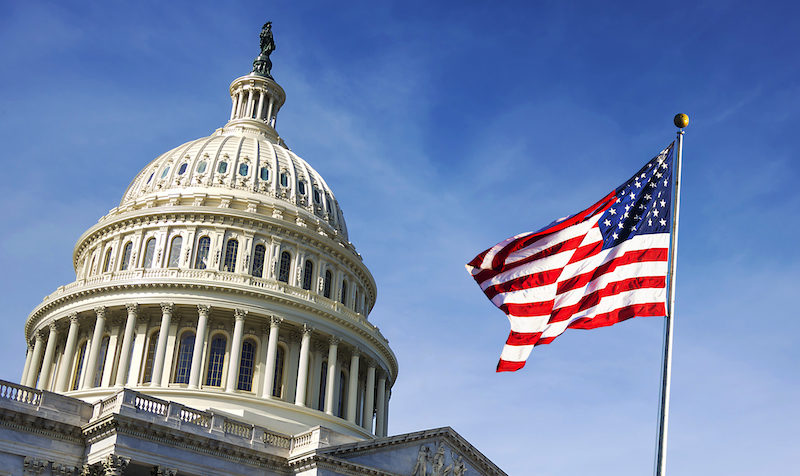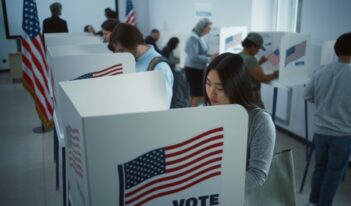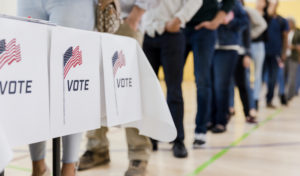
A constitutional amendment for voting procedures is necessary to protect the right to vote for all Americans.
The urgency to vote has intensified in recent weeks. This urgency has been largely spurred by a horrifying video brought to the attention of the global community. The video shows the murder of George Floyd in South Minneapolis at the hands of four Minneapolis Police Department officers. Since the video’s release, Floyd’s death has ignited civil unrest in major cities across the United States, invoking a long overdue dialogue around white supremacy, racial injustice, and police violence.
Although protests in the aftermath of George Floyd’s death have sparked demands for an end to racial inequality and excessive use of police force, calls to protect and strengthen the importance of voting have also intensified.
One positive step toward protecting this right would be a right-to-vote amendment to the U.S. Constitution.
Often in hopes of assuaging the qualms of protesters and the oppressed, concerned members of the public tend to move from unpacking the deep pain and hard truths of racial inequality in America and hastily rush to the question, “Where do we go from here?”
The burden answering this question does not rest with Black America to educate the broader population on how to bring to life the founding principle in the United States that “all men are created equal, that they are endowed by their creator with certain unalienable rights, that among these are life, liberty and the pursuit of happiness.” The current attention to the plight of Black Americans has brought to the forefront this very ideal, but it also calls into question whether their equality and humanity exists merely as an abstraction.
As Black Americans plead their unalienable rights of life and liberty, President Barack Obama recently released a compelling article on forging a path toward a more equitable and just society. Obama emphasized the duality of protest and politics, suggesting that the answer to the question of where we go from here lies in politics and, by extension, in policy. In other words, we cannot understand the urgency for which political change is necessary until we explore the deliberate and methodical eroding of a fundamental pillar in our democracy: the right to vote.
The U.S. Supreme Court’s 2013 decision in Shelby County v. Holder, in which the Court struck down key parts of the Voting Rights Act of 1965 (VRA), is as overt an example of voter suppression as they come.
The need for legislation protecting the right to vote originally arose because several states—particularly southern states—had maintained literacy tests, moral character requirements, and poll taxes during the Jim Crow era. Because of these barriers, racial disparities in voter turnout became too significant to ignore. White citizens were turning out to vote at a rate approximately 50 percent higher than Black American citizens in the South. The U.S. Congress, with hopes to curb the ubiquitous practice of voter disenfranchisement, decided to act and passed the VRA.
Within the VRA, Sections 4 and 5 emerged as profound congressional measures. Section 4 established—among other actions—a suspension of “a test or device” that infringed on voting rights and created a “coverage formula” for the federal government to identify jurisdictions with discriminatory voting practices. Section 5 required those jurisdictions to have all election law changes approved by either the U.S. District Court of the District of Columbia or by the U.S. Attorney General—a process known as “preclearance,” which aimed to thwart efforts to impose voting impediments on minority voters.
Despite congressional attempts to curb minority voter disenfranchisement, the Court’s opinion in Shelby County, which dealt a blow to Sections 4 and 5, embodies reasoning that is at best one-dimensional. Chief Justice John Roberts, writing on behalf of the Court, argued that the jurisdictions in question no longer needed federal oversight for their practices: “A statute’s ‘current burdens’ must be justified by ‘current needs,’ and any ‘disparate geographic coverage’ must be sufficiently related to the problem that it targets.” Referring to data that suggested that Blacks registered to vote at comparable rates in the targeted jurisdictions involved in the Shelby County case, Roberts made a nod to a post-racial society by concluding that “there is no longer such a disparity.”
In dissent, Justice Ruth Bader Ginsburg argued that the VRA is still essential. Even though the 15th Amendment still prohibits states from denying a citizen the right to vote based on race, Ginsburg wrote that “throwing out preclearance when it has worked and is continuing to work to stop discriminatory changes is like throwing away your umbrella in a rainstorm because you are not getting wet.”
After the Court handed down its decision in Shelby County, Texas and North Carolina swiftly enacted voter identification laws that restrict voting for some individuals. Congress has investigated these states—as well as Georgia and Kansas—for alleged voter suppression.
The U.S. Constitution does not explicitly guarantee the right to vote. Currently, constitutional amendments prohibit discrimination based on race, sex, and age. But states can adopt laws that do not reference race or color directly and yet still deprive Black Americans and others of their fundamental right to participate in democracy. This is why a statute such as the VRA is insufficient. The United States needs a constitutional amendment.
A right-to-vote amendment would go beyond the 26th Amendment—which merely protects voters over 18 years old from age discrimination in their right to vote. A new amendment would, for example, ensure that voting procedures in the more than 10,000 different U.S. jurisdictions do not vary as widely as they do now. A constitutional amendment could also protect voting during curfews, provide a guarantee of delivery of mail-in ballots, and ensure sufficient voting sites in all jurisdictions. Moreover, an amendment could protect citizens abroad as well as allow out-of-state college students to register in their college precincts.
Democratic expression should not be subject to the charity of governors and secretaries of state across the country. The United States needs constitutional protection of fair and consistent voting procedures.
To be clear, a right-to-vote amendment is not a panacea for redressing institutional and structural harm to Black Americans. But it is a constructive reform—one that should be apolitical. A right-to-vote amendment would counteract the deliberate attempts states have made to dilute Black political power and would also move Blacks closer to representation that resembles the diverse fabric of the United States. The right to vote in the United States should be protected for all Americans.
Demisse Habteselasie is a student at the University of Pennsylvania Law School.



